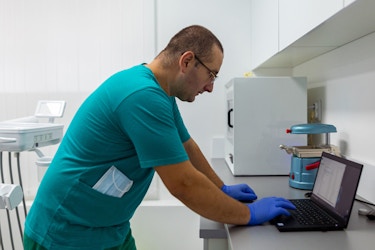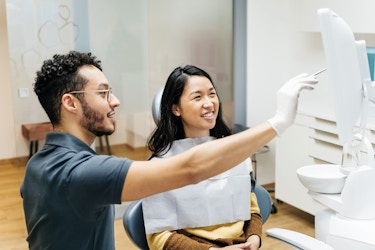
You know you can ask Alexa to play music while you’re busy prepping dinner. And you know you can scan your smartphone to pay for a Starbucks latte. But do you know what these (and other) consumer tech trends mean for your business?
We spoke to business leaders and retail experts to find out more about the technologies — from voice commerce to augmented reality and artificial intelligence — that are affecting businesses big and small. Here are the six tech trends you should be paying attention to right now.
Cashless commerce
Grab and go. Tap and pay. These catchy calls to action entice shoppers to get on their way fast, whether exiting an Uber ride or a store that has no checkout lanes. Technology enabling next-generation cashless transactions comes in many forms — such as chip-embedded key fobs, smartphones and mobile ride-sharing apps. Because these transactions do not require PIN code entry, credit slip signatures or cash handling, they’re super speedy.
While no one pretends to know what technology ultimately will win over the masses, consumers’ increasing demand for speed and convenience signals it’s time for businesses to craft a mobile payment strategy. So how do you create such a strategy? The experts we spoke to recommend a holistic approach, where cashless payments represent one step on the path to increasing convenience and customer satisfaction.
Augmented reality
Augmented reality, or AR, is technology that superimposes information — like digital images or text — on the real world (usually through the lens of a smartphone camera). You’ve probably heard about AR in the context of mobile gaming (think: Pokémon Go), but big brands and retailers, like L’Oreal and Wayfair are also using this technology to offer a realistic “try-before-you-buy” visual experience that helps assure shoppers of their purchase decisions.
While smaller businesses may not have the resources to develop their own AR technologies, they do have the ability to jump on the AR bandwagon in a more cost-effective way, says Chris Baker, founder of social media agency Totem Media, who told us that social platforms like Facebook and Snapchat provide inexpensive opportunities for brands to experiment with AR to find out how the tech resonates with their customers and whether this technology might warrant further investment.
Personalizing customer experience
Enhancing the customer experience has become a key strategy for brands seeking to differentiate themselves and grow their sales in highly competitive industries. In the food industry, pizza chains paved the way to more personalized customer service with user-friendly ordering apps, Starbucks raised the bar with its digital loyalty program and personalized product offers and McDonald’s recently made an acquisition that will enable the food chain to provide product suggestions to e-commerce shoppers based on their orders and other variables.
While the data collection tactics of these huge brands may seem out of reach for smaller businesses, there are a few basic steps businesses can take to collect information about their customers that can lead to greater personalization. First and foremost, businesses need to build up the digital channels (i.e., social media posting and email campaigns) they use to communicate with customers, said Mary Martin, a partner at Boston Consulting Group. Customer loyalty programs, Martin noted, are also a proven way for businesses to glean insights into customer preferences and identify opportunities to personalize the customer experience.
Voice is to the future of retail as walking erect was to human evolution — a critical next step.
Thornton May, technology futurist and anthropologist
Voice commerce
Voice commerce encompasses shopping and purchasing activities that use voice-recognition technology and artificial intelligence (AI) to interpret and respond to the spoken word from live human beings.
“Voice is to the future of retail as walking erect was to human evolution —a critical next step," technology futurist and anthropologist Thornton May told us. Other tech experts, Sterling Hawkins, co-founder of Center for Advancing Retail & Technology, Los Angeles, sees potential for voice commerce but is a bit more measured about where it applies. Businesses considering whether voice assistants might fit into operations need to use the technology themselves, he said.
“The most important thing is to engage with it. Engage by bringing in vendors, conversations at trade shows, pilot testing and use it as a consumer,” Hawkins told us.
Artificial intelligence
Good customer service is enough to make or break a purchase, and digitally native hair care company Madison Reed is one of the brands that has realized and addressed this by implementing an artificial intelligence (AI)-powered chatbot that communicates with customers who have questions or are looking for the perfect hair color shade. The chatbot (her name is Madi), can be accessed through text message and Facebook. She offers the customer options like, “Get Color Matched” or “Live Chat Support.” If the customer chooses to get color matched, a selfie can be sent directly to Madi so she can provide color suggestions.
Even businesses that primarily operate in the real world, like Walgreen’s, are flirting with responsive in-store technologies, such as interactive shelf displays and AI-powered virtual demos, that bring products to life in new ways while amassing valuable data on shoppers’ in-store behavior to continually enhance the experience.
Predictive analytics
“In the retail industry, the single most difficult decision in the entire equation is not necessarily what to buy, but how much,” said Theo Rose, a principal at New York-based consulting firm Applied Retail Transformation Ltd.
Historically, retail apparel merchandisers have relied on a combination of in-store testing and intuition to make decisions about what items to carry and how to price them — which can be time-consuming and often costly, when items that miss the mark with customers need to be marked down.
To make the process more effective and expedient, retailers like rue21 have begun working with technology companies that apply predictive analytics to the evaluation of potential new items and their optimal price points before bringing the items into the stores. The system works by sending out brief surveys in which the retailer asks customers to evaluate potential new items and provide feedback on suggested prices. The surveys are positioned as “games” to the retailer’s young audience, and often sent through social media platforms such as Instagram. The whole feedback loop takes a matter of hours, compared with the many months that traditional in-store tests can encompass.
CO— aims to bring you inspiration from leading respected experts. However, before making any business decision, you should consult a professional who can advise you based on your individual situation.
CO—is committed to helping you start, run and grow your small business. Learn more about the benefits of small business membership in the U.S. Chamber of Commerce, here.








